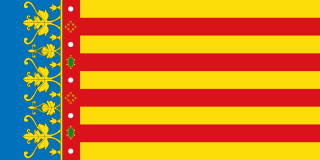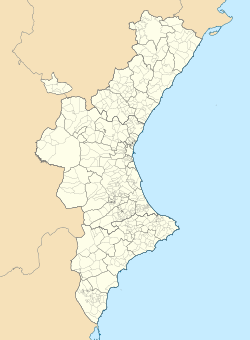
Catalan, known in the Valencian Community and Carche as Valencian, is a Western Romance language. It is the official language of Andorra, and an official language of two autonomous communities in eastern Spain: Catalonia and the Balearic Islands. It is also an official language in Valencia, where it is called Valencian. It has semi-official status in the Italian comune of Alghero, and it is spoken in the Pyrénées-Orientales department of France and in two further areas in eastern Spain: the eastern strip of Aragon and the Carche area in the Region of Murcia. The Catalan-speaking territories are often called the Països Catalans or "Catalan Countries".

Benabarre, in Ribagorçan and Aragonese: Benavarri is a town and municipality in the Aragonese comarca of Ribagorza, in the province of Huesca, Spain.

Valencian or Valencian language is the official, historical and traditional name used in the Valencian Community of Spain, and unofficially in the El Carche comarca in Murcia, to refer to the Romance language also known as Catalan. The Valencian Community's 1982 Statute of Autonomy and the Spanish Constitution officially recognise Valencian as the regional language.

The Catalan Countries are those territories where the Catalan language is spoken. They include the Spanish regions of Catalonia, the Balearic Islands, Valencian Community, and parts of Aragon and Murcia (Carche), as well as the Principality of Andorra, the department of Pyrénées-Orientales in France, and the city of Alghero in Sardinia (Italy). It is often used as a sociololinguistic term to describe the cultural-linguistic area where Catalan is spoken. In the context of Catalan nationalism, the term is sometimes used in a more restricted way to refer to just Catalonia, Valencia and the Balearic Islands. The Catalan Countries do not correspond to any present or past political or administrative unit, though most of the area belonged to the Crown of Aragon in the Middle Ages. Parts of Valencia (Spanish) and Catalonia (Occitan) are not Catalan-speaking.

Syndic is a term applied in certain countries to an officer of government with varying powers, and secondly to a representative or delegate of a university, institution or other corporation, entrusted with special functions or powers.

El Papiol is a municipality in the comarca of the Baix Llobregat in Catalonia, Spain. It is situated on the left bank of the Llobregat river, on the A-7 autopista from Valencia to La Jonquera and the C-1413 road from Sabadell to Molins de Rei. At West it borders on Castellbisbal and Pallejà, at North on Valldoreix and at East on Molins de Rei. It is served by the RENFE railway line R4 from Barcelona to Martorell, Vilafranca del Penedès and Sant Vicenç de Calders, which is connected to the village center by a minibus service. It is also served by a bus service (L67) and a night bus service (N51) from Barcelona to Esparreguera.

Olesa de Bonesvalls is a village and municipality in the Alt Penedès comarca in Catalonia, Spain. Until 1990 it was included in Garraf comarca.

Sagunto is a municipality of Spain, located in the province of Valencia, Valencian Community. It belongs to the modern fertile comarca of Camp de Morvedre. It is located c. 30 km north of the city of Valencia, close to the Costa del Azahar on the Mediterranean Sea.
The names of the Valencian Community are diverse, even though Comunitat Valenciana is the only denomination with official status in its Statute of Autonomy. Nonetheless, this legal document includes in its Preamble other legal denominations that portray the history and nature of the territory: Regne de València and País Valencià.

Alcanar is a Spanish municipality of the Catalan comarca of Montsià, in the Tarragona province. It is a coastal town on the Mediterranean Sea. The Serra del Montsià range and its foothills rise above the town and its surroundings. According to data from 2006 its population is 9,620 inhabitants, although this increased the next year, to 9,969. It is the southernmost town in Catalonia, located just north of the border with the municipality of Vinaròs which is in the province of Castellón and part of the region of Valencia.

The Valencian Community is an autonomous community of Spain. It is the fourth most populous Spanish autonomous community after Andalusia, Catalonia and the Community of Madrid with more than five million inhabitants. Its homonymous capital Valencia is the third largest city and metropolitan area in Spain. It is located along the Mediterranean coast on the east side of the Iberian Peninsula. It borders Catalonia to the north, Aragon and Castilla–La Mancha to the west, and Murcia to the south, and the Balearic Islands are to its east. The Valencian Community is made up of three provinces: Castelló, Valencia and Alicante.
Rafael Lluís Ninyoles i Monllor was a Spanish sociolinguist, considered one of the parents of Catalan sociolinguistics along with Lluís Vicent Aracil i Boned.

Valencians are the native people of the Valencian Community, in eastern Spain. Legally, Valencians are the inhabitants of the community. Since 2006, the Valencian people are officially recognised in the Valencian Statute of Autonomy as a nationality "within the unity of the Spanish nation". The official languages of Valencia are Valencian and Spanish.

Club Deportivo Acero is a Spanish football team based in Puerto de Sagunto, in the Valencian Community, Spain. Founded in 1919 it plays in Tercera División RFEF – Group 6, holding home games at Estadio El Fornàs, which has a capacity of 4,500 spectators.

The Catalan dialects feature a relative uniformity, especially when compared to other Romance languages; both in terms of vocabulary, semantics, syntax, morphology, and phonology. Mutual intelligibility between its dialects is very high, estimates ranging from 90% to 95%. The only exception is the isolated idiosyncratic Alguerese dialect.

Valencian Gothic is an architectural style. It occurred under the Kingdom of Valencia between the 13th and 15th centuries, which places it at the end of the European Gothic period and at the beginning of the Renaissance. The term "Valencian Gothic" is confined to the Kingdom of Valencia and its area of influence, which has its own characteristics.

Sagunto Castle is a fortress overlooking the town of Sagunto, near Valencia in Spain. The site's history extends back over two thousand years and includes Iberian, Roman and medieval remains. During the Islamic period, the castle was known as Murbĩtar and Morvedre. The castle was declared a National Monument in 1931.

Valencian Art Nouveau, is the historiographic denomination given to an art and literature movement associated with the Art Nouveau in the Valencian Community, in Spain.

Maria Ibars i Ibars (1892–1965) was a Valencian writer and teacher who wrote in Spanish and Catalan.
Altos Hornos del Mediterráneo S.A. (AHM) was a Spanish ferrous metallurgy company incorporated in 1971 to operate the integral ferrous metallurgy in Sagunto, known as the 4th Integral Ferrous Metallurgy Plant of Spain. At the time of its creation, it inherited the historical facilities that Altos Hornos de Vizcaya had owned in Sagunto since the beginning of the 20th century. However, the company's activity was strongly affected by the industrial crisis that the country experienced in the 70's and 80's, so that in 1984 the public administration agreed to cease its operations.






















